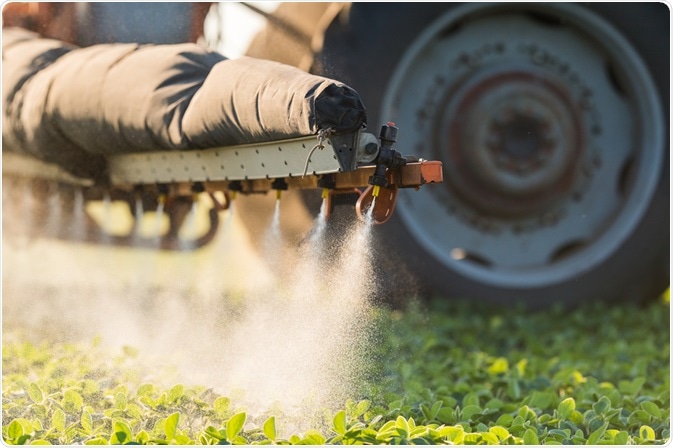Biopesticides are derived from living organisms such as bacteria or plants, with common use examples dating back to the 1950s. For example, Bacillus thuringiensis is a Gram-positive bacterium popularly used as an insecticide since then, exerting this activity through the formation of crystal proteins.
Upon ingestion of these proteins, the alkaline digestive tract of insects denatures the insoluble crystal proteins into a soluble form, allowing them to undergo proteolysis by enzymes found in the gut. The liberated toxin then damages the digestive tract locally, usually causing the insect to starve to death.
The gene for producing the crystal proteins has since been incorporated into crops by genetic modification, providing a degree of immunity from insect pests. Humans and most other non-target insects lack the receptor that enables the mechanism of the toxin, making the crops safe for consumption, and potentially avoiding the use of more toxic and environmentally damaging chemical pesticides.

Pesticides. Image Credit: Fotokostic/Shutterstock.com
Fungi as a pesticide
Many other bacteria with utility in pest control have since been discovered and deployed, acting via a wide range of mechanisms that may preferentially target one post over another. Besides bacterium, some fungi have also been found to exert exploitable toxicity towards a pest population.
Phoma macrostoma Montagne is a fungus that is used as a herbicide against a wide range of broad-leaf weeds such as dandelion and chickweed, causing photobleaching symptoms by inhibition of carotenoid synthesis. The fungus produces several chemicals of the group known as macrocidins that are responsible for the disruption of carotenoid synthesis in the leaves and subsequent death, similarly to the general mode of action of several types of synthetic herbicide.
However, the mechanism of action of macrocidins is more complex, with recent studies suggesting that the chemicals inhibit phytoene desaturase enzymes, possibly by sequestering iron and magnesium cations within their macro-structure and subsequently facilitating electron transfer, though this is not yet entirely clear. These chemicals, and the fungus from which they derive, appear to be safe for human and animal consumption, and so could replace more toxic alternatives.
Crop disease management
Bacillus subtilis is a Gram-positive bacterium able to tolerate extreme environmental conditions and has been used as part of a wider biopesticide strategy for crop disease management. The bacteria can transition from a cell to a highly resistant long-lasting spore when nutrients are depleted, allowing it to then revive once conditions improve or the spore is moved.
In nature bacteria competes with other microorganisms and forms a biofilm on plant roots, secreting metabolites that are toxic to plant pathogens: other bacterium, fungi, etc. Bacillus subtilis are also through to promote plant growth by sequestering nutrients, producing phytohormones, and promoting the plant's own systemic resistance. Therefore, sustained colonization of crop fields by Bacillus subtilis is beneficial to many plants, acting as a general pesticide and growth promoter that can be used synergistically with other pest control approaches.
A large number of antimicrobial peptides have been isolated from the bacteria, noted to be synthesized by either a non-ribosomal or ribosomal peptide synthesis route. The former route generates, among other forms, lipopeptides, which are amphiphilic and therefore disrupt the cell membrane of bacterium and fungi plant pathogens, while the latter generates post-translational modified bacteriocins that are capable of broad-spectrum activity towards Gram-positive bacteria and a narrower spectrum of Gram-negative.
Insect viruses
Antimicrobial pathogens of insects have also been proposed as a possible control strategy, particularly attractive due to the narrow range of insect hosts affected, thus avoiding the elimination of pest predators and other non-target organisms that is associated with the use of broad-spectrum chemical insecticides.
Baculoviruses are a group of large DNA viruses known to infect insects that produce large protein crystals on their surface named occlusion bodies, making them easily identifiable using a microscope. These protein crystals make the viruses very stable in extreme environments, and when digested within the alkaline insect gut generate virions that infect local cells and propagate infection.
The virus does not produce any toxins and thus is slower in killing the infected infect, but it replicates to high viral load and is highly transmissible, being extremely persistent in an insect population. Death is caused by the diversion of nutrients and commandeering of the metabolic cycle towards virus production, though the virus also influences the specific insect host in several other ways, inducing molting and other degrading effects.
Interestingly, insect larvae infected with baculovirus show an increased propensity to wander and climb, enhancing the dispersion of the virus throughout the host’s environment. Infected cadavers appear to “melt” due to the production of enzymes by the virus in late-stage infection, further enhancing the spread.
References:
Further Reading